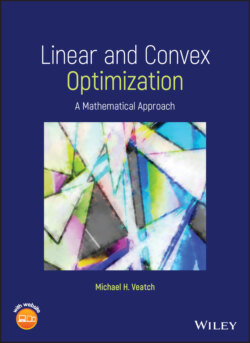Читать книгу Linear and Convex Optimization - Michael H. Veatch - Страница 21
1.4.2 Integer Programs
ОглавлениеMany practical optimization problems involve making discrete quantitative choices, such as how many fire trucks of each type a fire department should purchase, or logical choices, such as whether or not each drug being developed by a pharmaceutical company should be chosen for a clinical trial. Both types of situations can be modeled by integer variables.
Consider again the linear program (1.1) with the alternative objective function (1.2). The variables represent the number of pallets of tents and food. If we restrict the variables to be integers, i.e. we can only load whole pallets, then the problem becomes an integer program and can be stated
(1.5)
Without the integer restriction, it is a linear program with optimal solution and optimal value . However, because this solution is not integer (i.e. not all of its variables have integer values), it is not feasible for the integer program. Only solutions that have integer values and satisfy the constraints are feasible, as shown in Figure 1.4. Once we have determined the feasible points, an optimal solution can be found graphically by sweeping the contour line in the improving direction (upward). The last point touched by the line is optimal. In this case the last point is and the optimal value is .
Figure 1.4 Feasible integer solutions for (1.5).
Although the graphical method was fairly simple for this example, it is quite different than when solving linear programs. Note that:
There is not necessarily an optimal solution at the intersection of two constraints. In our example, lies only on the constraint line . In other examples, the optimal solution may not lie on any constraint.
The optimal solution is not necessarily obtained by rounding the linear program optimal solution. In fact, there is no limit to how far the optimal solution could be from the linear programming solution.
The integer program can be infeasible when the linear program is feasible.
These difficulties suggest that integer programs are harder to solve than linear programs, which we will see is true. Even solving a two‐variable integer program graphically can be tedious. However, we do not necessarily need to generate all integer feasible solutions. For example, if we start by generating the feasible point , then we draw the contour line through it and check for integer points in the linear program's feasible region and above the contour. Checking points to the right of (because this contour does not touch the feasible region for ), is infeasible but qualifies, so it is optimal. The idea of using a feasible integer solution to eliminate other integer points from consideration will be used in Chapter 13.
The general form of an integer program is the same as a linear program with the added constraint that the variables are integers. If only some of the variables are restricted to be integer, it is called a mixed integer program. When variables represent logical choices, they are usually defined so that if true (decide to take the action) and if false (decide not to take the action). A variable whose possible values are is called a binary variable. An integer program with all binary variables is called a binary program.
